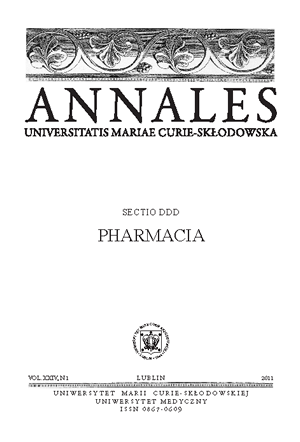Phytoestrogens – classification, occurrence and significance in the prevention and treatment of osteoporosis
Keywords:
phytoestrogens, osteoporosis, Glycine max (L.) Merr., Cimicifuga racemosa Nutt., Pueraria lobata (Willd.) OhwiAbstract
The object of this publication is the review of the literature concerning the classification, sources of phytoestrogens and their medicinal significance. Phytoestrogens are not a group of compounds, which are separated on the basis of chemical affinity, but due to the physiological effects they have on the human body. They are present in many representatives of the world's flora and form together with mykoestrogens and xenoestrogens a group of environmental estrogens. Phytoestrogens fulfill a series of important functions in a living organisms, for example their presence in a diet may decrease the probability of many diseases including osteoporosis.
References
1. Arjmandi B., Khalil D., Smith B. et al.: Soy protein has a greater effect on bone in postmenopausal women not on hormone replacement therapy, as evidenced by reducing bone resorption and urinary calcium excretion. J. Clin. Endocrinol. Metab., 88, 1048, 2003.
2. Cornwell T., Cohick W., Raskin I.: Dietary phytoestrogens and health. Phytochem., 65, 995, 2004.
3. Delmonte P., Perry J., Rader J.: Determination of isoflavones in dietary supplements containing soy, Red Clover and kudzu: Extraction followed by basic or acid hydrolysis. J. Chromatogr. A, 1107, 60, 2006.
4. Foltyn W., Kos-Kudła B., Siemińska L. et al.: Osteoporoza i miażdżyca – wspólna etiopatogeneza? Endokr. Pol., 3, 316, 2003.
5. Gehm B., McAndrews J., Chien P., Jameson J.L.: Resveratrol, a polyphenolic compound fund in grapes and wine, is an agonist for the estrogen receptor. Proc. Natl. Acad. Sci. USA, 94, 14138, 1997.
6. Głowniak K., Widelski J., Skalicka-Woźniak K.: Lucerna – niedoceniony surowiec leczniczy. Panacea, 3, 10, 2007.
7. Ibarreta D., Daxenberger A., Meyer Hhd.: Possible health impact of phytoestrogens and xenoestrogens in food. Apmis., 109, 161, 2001.
8. Janeczko Z., Jurczyszyn A., Bochenek B.: Właściwości biologiczne resweratrolu i możliwości jego stosowania w terapii szpiczaka mnogiego. Panacea, 2, 9, 2009.
9. Kerstetter J. E., Wall D.E., O’Brien K.O. et al.: Meat and soy protein affect calcium homeostasis in healthy women. J. Nutr., 136, 1890, 2006.
10. Kohlmünzer S.: Farmakognozja. PZWL. Warszawa 2007.
11. Kraszewska O., Nynca A., Kamińska B., Ciereszko R.: Fitoestrogeny. I. Występowanie, metabolizm i znaczenie biologiczne u samic. Post. Biol. Kom., 1, 189, 2007.
12. Kraszewska O., Nynca A., Kamińska B., Ciereszko R.: Fitoestrogeny. II. Wewnątrzkomórkowy mechanizm działania w układzie rozrodczym samicy. Post. Biol. Kom., 1, 207, 2007.
13. Lamer-Zarawska E., Kowal-Gierczak B., Niedworok J.: Fitoterapia i leki roślinne. PZWL. Warszawa 2007.
14. Murkies Al., Wilcox G., Davis Sr.: Phytoestrogens. J. Clin. Endocrinol. Metab., 83, 297, 1998.
15. Nieradko-Iwanicka B., Borzęcki A.: Osteoporoza jako problem pediatryczny. Probl. Hig. Epidemiol., 90, 27, 2009.
16. Olas B.: Antyoksydanty obecne w diecie w walce z miażdżycą. Kosmos, 2, 249, 2003.
17. Oleszek W., Stochmal A.: Triterpene saponins and flavonoids in the seeds of Trifolium species. Phytochem., 61, 165, 2002.
18. Ożarowski A.: Ziołowa terapia zastępcza w okresie przekwitania. Panacea, 2, 16, 2004.
19. Prescha A., Biernat J.: Wpływ fitoestrogenów pokarmowych na organizm człowieka. Bromat. Chem. Toksykol., 4, 941, 2008.
20. Rahnama M., Błoniarz J., Zaręba S., Świątkowski W.: Wpływ fitoestrogenów na gęstość mineralną kości (BMD żuchwy, kręgosłupa, kości udowej). Bromat. Chem. Toksykol., 3, 642, 2009.
21. Strzelecka H., Kowalski J.: Encyklopedia zielarstwa i ziołolecznictwa. PWN. Warszawa 2000.
22. Wu Q., Wang M., Simon J.: Determination of isoflavones in red clover and related species by high-performance liquid chromatography combined with ultraviolet and mass spectrometric detection. J. Chromatogr. A, 1016, 195, 2003.
23. Zgórka G.: Studies on Phytoestrogenic and Nonphytoestrogenic Compounds in Trifolium incarnatum L. and Other Clover Species Using Pressurized Liquid Extraction and High Performance Column Liquid Chromatography with Photodiode-Array and Fluorescence Detection. J. AOAC Int., 94, 22, 2011.
Downloads
Published
Issue
Section
License
Copyright (c) 2011 Authors

This work is licensed under a Creative Commons Attribution-NonCommercial-NoDerivatives 3.0 Unported License.


